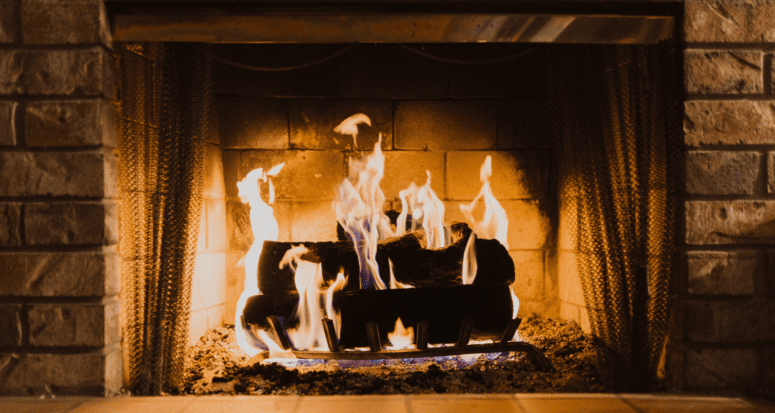Fireplace Inspections Keep Your Home Safe. Here’s What You Need to Know
- Published on
- 6 min read
-
 Lori Lovely Contributing AuthorClose
Lori Lovely Contributing AuthorClose Lori Lovely Contributing Author
Lori Lovely Contributing AuthorLori Lovely edited the Real Estate Home section for the Indianapolis Star and covered the annual Dream Home construction and decor for Indianapolis Monthly magazine. She has written guides for selling houses and more.
Some homeowners use their fireplace primarily for hanging Christmas stockings and displaying family photos on the mantel. Others like the warmth and atmosphere a crackling fire provides.
In Rochester, New York , it’s rare to find a home without a fireplace, according to Tiffany Hilbert, a top agent who specializes in single family homes in the Rochester area , although she concedes that a lot of them have been converted to gas.
Particularly for those who like to light up a cozy fire now and then, it’s important to ensure that your fireplace is operating correctly in order to keep your family and your home safe. If you don’t remember the last time you had your fireplace inspected, it’s time to schedule one.
Fireplaces still provide the primary heating source for nearly one-third of U.S. homes. Recent statistics reveal more than 25,000 chimney fires occur in the U.S. each year, causing $125 million in property damage and 10 deaths a year.
Most chimney and fireplace fires are preventable. According to the National Fire Protection Association (NFPA), about 28% of home heating fires result from dirty equipment — usually chimneys. Creosote build-up — a black, tar-like substance — is one of the largest contributors to chimney fires.
A fireplace inspection can alert the homeowner to creosote buildup, as well as other dangers, such as a damaged fireplace or chimney. An inspection can ultimately prevent disaster.
For guidance on how often you should have your fireplace inspected and what to expect, we spoke to Hilbert and Russ Dimmitt, director of education for the Chimney Safety Institute of America (CSIA) and we did some in-depth research.

Fireplace inspections check these features
A home inspection covers some fireplace components, according to the American Society of Home Inspectors, but not all. The flue, seals and gaskets, fireplace surrounds, and other components are not included in a home inspection.
That’s why it’s important to schedule a fireplace inspection every one to two years (or more often if you use your fireplace frequently). What it covers depends on the level of fireplace inspection requested.
There are three types of chimney inspections
Not all inspections are the same. There are three levels of chimney inspections. Your situation dictates which type you need.
Level One
A Level 1 inspection is the minimum requirement and is typically recommended when things haven’t changed: usage, service, materials burned, and the components themselves. Also, if no damage has occurred, a Level 1 is appropriate.
“It’s routine maintenance,” Dimmitt says. “According to the National Fire Prevention Association, a fireplace should be inspected and swept annually.”
Using a flashlight but no special equipment, the inspector will visually examine the readily accessible portions of the chimney’s exterior and interior, as well as the accessible portion of the appliance and the chimney connection. The inspector will look at the basic soundness of the chimney structure and flue, the connections, and the installation. They will confirm that all components work properly. They will also check to see that the chimney has no damage, obstructions, creosote buildup, soot, or combustible deposits.
Level Two
If changes are made to the system – such as fuel type, shape of the flue, relining of the flue, replacement or addition of a different type of appliance – or, Dimmitt interjects, if something is found in a Level 1 inspection, a Level 2 inspection is required. It is also necessary for the sale or transfer of property and after an operation malfunction or external event caused damage to the chimney. Building and chimney fires, seismic activity, and weather events (including lightning strikes) are examples of external events.
A Level 2 inspection includes a video scan of the internal surfaces and flue liners of the chimney. Typically, the inspector will also climb onto the roof and into the crawlspace to look for issues.
Level Three
Level 3 inspections are not common, Dimmit says. If an inspector can’t determine the cause of an issue discovered in a Level 2 inspection or if a hidden hazard is suspected but inaccessible without special tools or some dismantling of the structure, a Level 3 inspection becomes necessary. It addresses the proper construction and condition of concealed parts of the chimney and flue.
Often performed after a chimney fire, a Level 3 inspection is invasive and can be destructive because it may include tearing down and rebuilding chimney walls.

Common fireplace inspection findings
“Sweeping isn’t hard,” Dimmitt says, “but you have to know what you’re doing for an inspection.” Inspections can uncover a myriad of problems. Here’s a list of some of the issues commonly detected during an inspection.
Creosote
Perhaps the most common issue seen during a fireplace inspection is excess creosote. This highly flammable substance accumulates on the walls of the chimney and other areas as a result of burning wood. Creosote buildup can eventually cause a chimney fire, which can do serious damage to the chimney and even the house.
The best way to eradicate creosote is to hire a chimney sweep to clean the chimney. The cost of hiring a chimney sweep to check for deposits and correct clearance averages $244.
Obstructions
Lots of things can get into a chimney and get stuck: leaves, twigs, branches, dirt, litter, and even birds and animals. Blockages pose a potential fire risk and can prevent smoke from escaping the chimney, forcing it to back up into the house. This can be particularly dangerous if carbon monoxide invades the home.
One way to clear obstructions is with a chimney sweep. Installing a chimney cap can help prevent future obstructions. The average cost for a contractor-installed chimney cap is $175. Added benefits of a chimney cap include preventing water from seeping in and causing damage to the stack and some prevention of sparks and embers from rising out of the chimney to land on the roof, where they could potentially cause a fire.
Structural issues
A fireplace inspection may detect structural issues, such as cracks in the flue or chimney cap, damaged mortar, deteriorating brickwork, or a smoke chamber that has holes or gaps. Any of these could progress to a chimney crumbling and falling apart.
Dimmitt says missing flue joints, broken flue tiles, and misaligned flue tiles are the most common issues most inspectors see. “They’re all safety issues,” he points out.
Tuckpointing can address damaged mortar by replacing it. It involves cutting a thin groove in the center of the new mortar joint and filling it with a contrasting mortar color for a refined appearance. Typical cost is between $5 and $25 per square foot, although prices can be higher in areas where labor costs are high. Re-mortaring a chimney repairs or replaces cracked, crumbling, or otherwise damaged mortar. It costs $150 to $500 on average.
Chimneys are exposed to the weather all year round. “Moisture is the enemy of masonry,” Dimmitt says. Chimney sealing or waterproofing involves spraying a waterproofing agent onto the chimney to protect it from water damage. Average costs of sealing a chimney run from $150 to $500.
Chimney crowns, the cover of concrete or mortar at the top of the chimney, can be rebuilt to provide a water-tight and air-tight seal. The average cost of repairing a chimney crown is $900, with the typical range of $750 to $1,200.
Accessibility of the roof and location of the chimney can impact the cost. Other cost factors include the specific repair needed: chemical cleaners to remove algae or moss; sealing the crown to prevent moisture; caulking the cracks; or resurfacing if pieces are crumbling or missing entirely. Without a covering, Dimmitt explains, your chimney is subject to infestation by birds, squirrels, raccoons, or other wildlife.
The smoke chamber, which is located directly above the damper and below the flue, funnels smoke into the flue and out of the home. It should be smooth. If it has holes, cracks, gaps, or isn’t the proper thickness, it can become a fire hazard.
A damaged smoke chamber must be parged – a process of applying a fresh coat of mortar to the bricks to create a smooth surface. This usually costs between $500 and $2,000.
Chimney brick replacement may be necessary if bricks are cracked, broken, or missing. Costs generally range from $100 to $1,000 depending on how many bricks need replacing and how easy they are to access.
Chimney flashing protects the chimney from moisture ingress. Over time, cracks and holes can appear. Storms may cause further damage. Replacement of chimney flashing averages between $300 and $800.
Chimney liners, which guard against fire, corrosion, and wear, can become damaged or worn. Replacement costs $1,200 to $4,600 depending on the material (such as clay or stainless steel) and size.
Chimney flues rarely need to be replaced, but tend to be one of the most expensive repairs. Most often, they are relined or resurfaced, but extensive damage may require complete replacement at an average cost of $3,000 to $7,000.

Fireplace inspections can cost as little as $75 or as much as $5,000
The national average cost of a fireplace inspection ranges from $360 to $400. Of course, that fluctuates according to which level of inspection your fireplace needs and other factors, such as the condition of the chimney.
Some companies will waive the cost of the inspection if they are hired to complete any repair work.
- Level 1 inspections range from $75 to $200.
- Level 2 inspections range from $100 to $500.
- Level 3 inspections range from $1,000 to $5,000, depending on the chimney’s size and location.
Should the seller schedule a fireplace inspection?
Typically, it is the responsibility of the buyer to request a fireplace inspection. Even if the seller provides a report from a chimney sweep as part of home disclosures, some buyers prefer to hire an independent inspection.
In fact, it has become a trend for buyers to request additional inspection services. If an inspection finds any problems, the buyer can use this as a negotiating tool.
However, Hilbert says, “It’s not usually a deal-breaker.” In fact, she seldom sees fireplace inspections in this competitive market in which inspections and contingencies may lose the deal.
But when one fireplace inspection went bad, to appease the requirements of the FHA loan, the seller had to cover it with a metal plate so it couldn’t be used. “It cost the seller [an additional] $350 to close.”
On the other hand, it’s not a bad idea for the seller to schedule a fireplace inspection. Doing so can protect the seller from lawsuits or other complications with the sale resulting from undisclosed issues.
Annual minimum
Although fireplaces aren’t as common as they once were – the National Association of Home Builders reported that in 2018 just 41% of single-family homes featured fireplaces, compared with 57% in 2001, and only 7% of new single-family homes priced under $150,000 in 2018 had fireplaces – any homeowner who has one needs to know how to properly maintain it if they intend to do more than merely hang their Christmas stockings on it.
Keep your family, pets, and home safe by scheduling a routine fireplace inspection.
As an incentive to schedule annual inspections, Dimmitt points out that: “A lot of things can be repaired cheaply. If they’re caught early. It gets expensive later.”
Header Image Source: (Hayden Scott / Unsplash)
